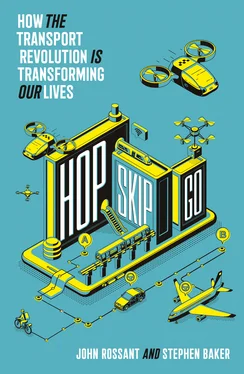City planners were also in the dark. Until recently, highway engineers would stretch cords equipped with counting sensors across roads. This provided primitive insights, but only on the behavior of our motorized herds. And engineers had precious few tools with which to manage the flow. Traffic, like a force of nature, simply happened. So most cities bowed to its unrelenting pressure and dedicated big chunks of their budgets to widening roads and highways, and opening up more space for parking. The resulting status quo was rife with waste—of energy, time, and money. The massive backups, the crawling lines of single drivers in five-thousand-pound hunks of metal, epitomized its inefficiencies.
The abundant waste found in the ignorant status quo spells boundless opportunity. Planners and entrepreneurs alike can now measure and count all kinds of things. As they do, they can sharpen their focus from the herd to the individual. This fuels new businesses. A commuter in Paris, for example, inches along the clogged Boulevard Périphérique at the wheel of a Renault Clio. Say there’s a service or an app that can slice a half hour off her commute, in each direction, freeing up five hours a week. What would she pay for those miles and minutes?
These are burgeoning markets of space and time. Most of them would have been beyond our reach until recently. But a host of enabling technologies are now at hand. Arrays of sensors can now provide second-by-second reads on our location. High-speed networks, including 5G, can zip that data to computing clouds. Advanced artificial intelligence can turn it into insights about where we’re going—and how best to get us there. Blockchain and other distributed ledger technologies, devised only a decade ago as the foundation for cryptocurrencies like Bitcoin, provide secure channels through which vehicles can share information and coordinate their actions. This sharing is fundamental for creating hyperefficient networks—even while we’re still behind the wheel.
One other fundamental technology is the battery. The new mobility machines run, for the most part, on electricity, which happens to be what computers eat. Most of the new conveyances, in essence, are networked computers fitted with wheels or wings. Even bikes are getting smart.
Mobility, as we see it, represents the third stage of the Internet. The networked age debuted in the final decade of the last century, when rich troves of information, from mail to music, went digital. In the following decade, with the explosion of smartphones, information went mobile. That was stage two. The marriage of the cell phone to a networked computer placed the universe of knowledge into our pockets and purses, and added what amounts to an electronic lobe to the human brain. We’re now accustomed, and even addicted, to carrying around networked technology. As we embark on stage three, ever more advanced blends of that technology are carrying us around .
In the coming age of mobility, practically every rolling and flying conveyance will be a networked device. For a glimpse of what this means, open a ride-sharing app, such as Uber or China’s DiDi. The dots on the screens provide a glimpse of the future, one in which each of us moves as a node on a network map.
Ride-sharing was the first big splash of a tech wave that had been hyped for two decades: the so-called Internet of Things. Refrigerators would order milk, we were told, and smart light bulbs would brighten when we walked into a room. A good number of these machine-to-machine applications are finally creeping into the marketplace. But the biggest and richest arena for the Internet of Things will be mobility. It dwarfs the rest of the field.
This doesn’t mean that the next cars we buy will be driverless, or that we’ll soon be gliding over rush hour traffic in autonomous flying pods. These technologies, as we’ll see, are in the works and will indeed be lifting off, in some places much sooner than others. For most of us, though, the coming transition will begin not with a miraculous new machine at the curb, but with a series of new questions.
Imagine you’re a twenty-nine-year-old, just out of grad school, taking your first good job. You’re in LA. The commute—the only real downside to the job—looks to be a fifty-minute rush hour crawl to and from Santa Monica, most of it on the I-10. You need a car.
The first thought is money. For an apartment renter like you, the car will be far and away your most valuable possession. You’ll need a loan to buy it. Factoring in price and maintenance, it will cost about $8,000 a year to own and maintain the car. And the dumb thing will be parked for about 95 percent of its existence. It’s a cash drain. Even parking it costs money. Car ownership isn’t all that different from caring for a needy animal and paying for regular visits to an expensive vet. In fact, if you consider expense and upkeep, and even function, the car has much in common with the high-maintenance mobility heavyweight it dethroned, the horse.
It’s at this point, with an auto dealer reaching for your wallet, that you might consider the shape of the coming decade you’ll be sharing with this hypothetical car. Will you really need it?
Try thinking about it the other way: Instead of a car, you have the $8,000 a year that owning it would cost. That’s your transportation fund. Even a decade ago, the money wouldn’t have gone far. There was no Metro train between downtown LA and Santa Monica. Bus service was a bad joke. Taxis—if you could find one in LA—were out of the question; they’d eat up $8,000 in a few months. The only choice back then was whether to buy a car or to lease one.
But the next decade will offer new choices, and more of them every year. Ride-sharing services and scooters are just the beginning. Los Angeles Metro, once an afterthought for the hordes on the highways, is expanding dramatically, thanks to billions of dollars in bonds approved by voters. Drivers, it turns out, were so desperate for relief that they funded transit by raising their own gas tax. For many, it’s a prayer that better public services will deliver a dose of relief for highway traffic and make driving tolerable once again.
The question remains: Do you spring for the car? While your options will continue to expand, complications remain. What do you do, for instance, when winter rains pelt down and the scooter ride from the Metro station is in the dark?
The answers still aren’t easy. Even as new networks and technologies take root over the coming decade, many of us will stick with the car—or be stuck with one. The mistake, though, is to expect that the next stage of mobility will be like the last, simply with smarter and cleaner machines. In this vision, we keep the driveway, the two-car garage, and the parking lots. We hold on to the entire automobile monoculture, but we replace the gas-powered machines we’ve been driving for the last century with zippy electric models that will eventually drive themselves.
It’s natural to think that way. Early in the twentieth century, many people assumed that automobiles would simply replace horses. Sure, they’d consume gas instead of oats, foul the air more than the roads, and run faster. And yes, when they broke down, it would be a mechanic, not a veterinarian, who’d coax them back to health. But the world would continue more or less the same. The name for these new machines said as much. They were “horseless carriages.”
The automobile, however, went on to mold much of the global economy, from manufacturing to oil. It also transformed urban geography. Over the last century, asphalt, a byproduct of oil refining, coated a good chunk of the planet, including the parts where most of us live. Asphalt is what cities wear.
Читать дальше












